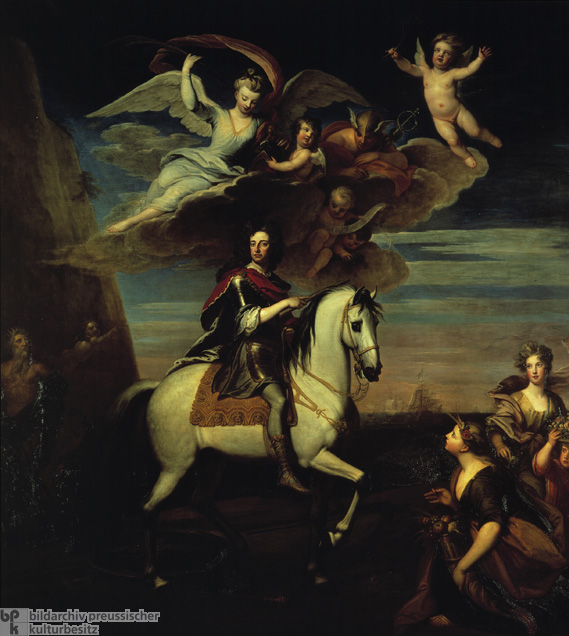













INTRODUCTION | DOCUMENTS | IMAGES | MAPS | EDITOR
|
The Dutchman William III of Orange (1650-1702) was the son of William II of Orange (1626-50) and Mary Stuart (1631-60), the eldest daughter of King Charles I of England. He was elected stadtholder and military chief of the Dutch Republic after the outbreak of the Dutch War (1672-78), which was forced on the Netherlands by an overwhelming coalition led by Louis XIV of France. In the first year of fighting, the only support William received came from Frederick William ("the Great Elector") of Brandenburg, his uncle by marriage, and Emperor Leopold I. Despite limited assistance, William mounted a determined defense, which saved the Dutch Republic from the threat of incorporation into France. Among other defensive measures, he ordered the opening of dykes to impede the enemy. In 1677, with the Dutch War still in progress, William married Mary (1662-94), his first cousin and the eldest daughter of King James II of England. In 1688, seven leading Whig politicians who opposed James’s Catholic and autocratic policies sent William a formal invitation to come England’s rescue. He agreed. On November 5, 1688, he landed in England with his army. James initially tried to resist but quickly relented and fled to France. A Convention Parliament was summoned in January 1689 to discuss the future of the government. In light of James’s “abdication,” the parliament decided to confer the British crown upon William and Mary, who were to rule as joint sovereigns. The parliament made clear, however, that their assumption of the crown was contingent upon their acceptance of the Declaration of Rights, which, as is clear in retrospect, started Britain on its path toward constitutional monarchy. The accession of William and Mary to the English, Scottish, and Irish thrones strengthened the European coalition in their fight against Louis XIV’s expansionism. This allegorical equestrian portrait of William III was executed by the German-born British court painter Sir Godfrey Kneller (1646-1723). The painting, which was probably commissioned by William himself, portrays him as a peacemaker and celebrates his return from the negotiations that led to the signing of the Peace of Ryswick on September 20, 1697. The painting shows a triumphant William surrounded by a host of mythological figures, including Neptune (far left), and Ceres and Flora (right foreground). Astraea, the personification of justice in Greek mythology, floats above William. She is joined by Mercury and various putti, one of whom holds a scroll that reads: PACATUMQUE REGIT PATRIIS VIRTUTIBUS ORBEM, a quotation from Virgil, which means “And he reigns over the pacified world with the virtues of his ancestors.” Painting by Sir Godfrey Kneller, 1701.
© Bildarchiv Preußischer Kulturbesitz |
 print version
print version return to image list
return to image list previous image
previous image
